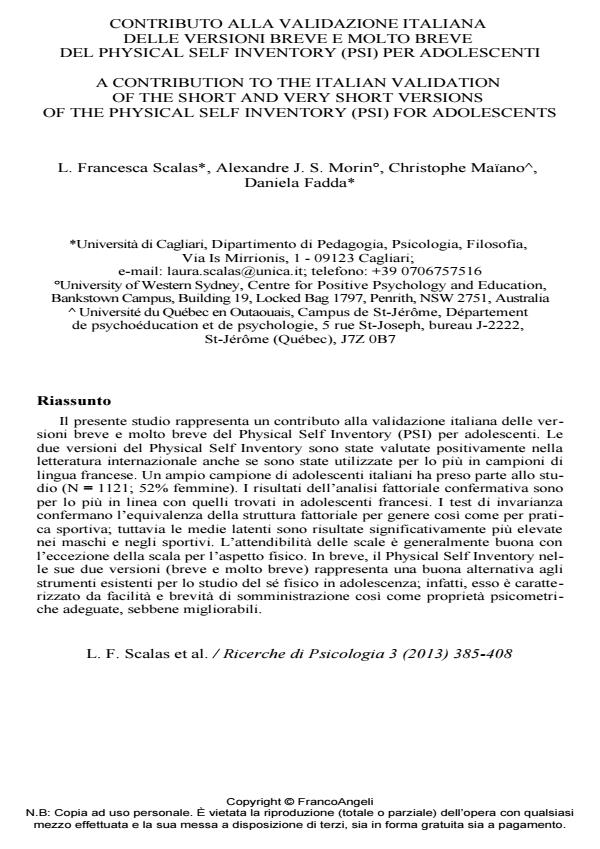A contribution to the italian validation of the short and very short versions of the physical self inventory (psi) for adolescents
Journal title RICERCHE DI PSICOLOGIA
Author/s L. Francesca Scalas, Alexandre J.S. Morin, Christophe Maiano, Daniela Fadda
Publishing Year 2014 Issue 2013/3
Language Italian Pages 24 P. 385-408 File size 299 KB
DOI 10.3280/RIP2013-003001
DOI is like a bar code for intellectual property: to have more infomation
click here
Below, you can see the article first page
If you want to buy this article in PDF format, you can do it, following the instructions to buy download credits

FrancoAngeli is member of Publishers International Linking Association, Inc (PILA), a not-for-profit association which run the CrossRef service enabling links to and from online scholarly content.
The present study is a contribution to the Italian validation of the short and very short forms of the Physical Self-Inventory (PSI) for adolescents. The two versions of the Physical Self Inventory have been positively evaluated by the international literature, but they have been used mainly in French speaking samples. A large sample of Italian adolescents have been involved in the study. Results of the confirmatory factor analysis were very similar to those based on French adolescents. Invariance tests confirmed equivalent factorial structures over gender, as well as over sport practice; however, the latent means were significantly higher in males and adolescents practicing sports. Reliability scores of the scales were generally good, with the exception of the physical appearance scale. Summarizing, the short and very short versions of the Physical Self Inventory represent a good alternative to the existing instruments to evaluate physical self-concept in adolescence. Indeed, the PSI is characterized by easy and short administration as well as adequate, but improvable, psychometric properties.
Keywords: Physical Self-Inventory, Italian validation, confirmatory factor analysis, gender invariance, sport invariance, adolescence.
- Validity and reliability of the Very Short form of the Physical Self-Inventory among Turkish adolescents F. Hülya Aşçi, Christophe Maïano, Alexandre J. S. Morin, Emine Çağlar, Naile Bilgili, in Journal of Sports Sciences /2017 pp.2060
DOI: 10.1080/02640414.2016.1255346
L. Francesca Scalas, Alexandre J.S. Morin, Christophe Maiano, Daniela Fadda, Contributo alla validazione italiana delle versioni breve e molto breve del physical self inventory (psi) per adolescenti in "RICERCHE DI PSICOLOGIA " 3/2013, pp 385-408, DOI: 10.3280/RIP2013-003001